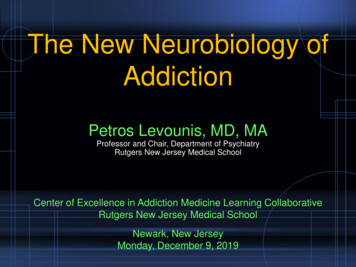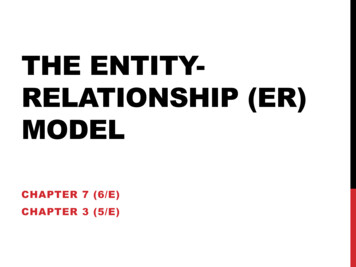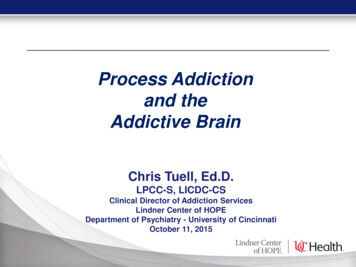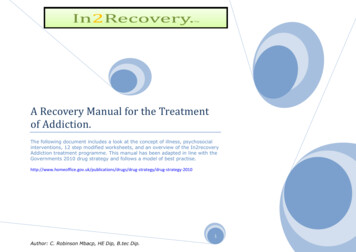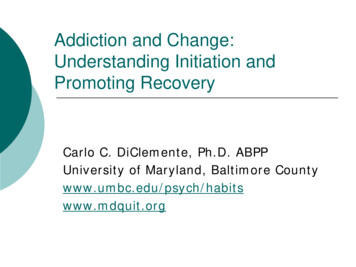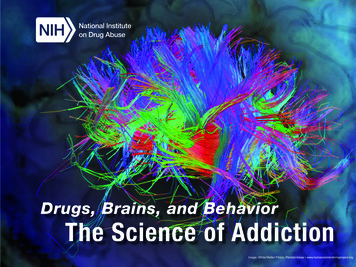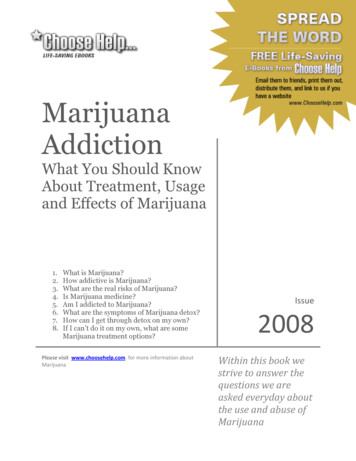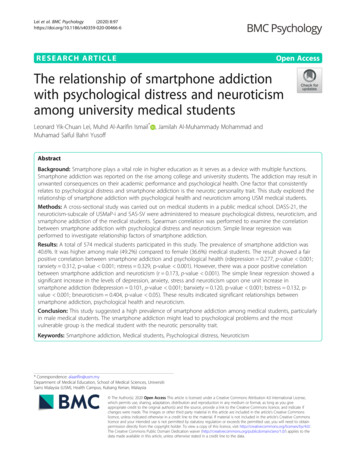
Transcription
Lei et al. BMC Psychology(2020) ARCH ARTICLEOpen AccessThe relationship of smartphone addictionwith psychological distress and neuroticismamong university medical studentsLeonard Yik-Chuan Lei, Muhd Al-Aarifin Ismail* , Jamilah Al-Muhammady Mohammad andMuhamad Saiful Bahri YusoffAbstractBackground: Smartphone plays a vital role in higher education as it serves as a device with multiple functions.Smartphone addiction was reported on the rise among college and university students. The addiction may result inunwanted consequences on their academic performance and psychological health. One factor that consistentlyrelates to psychological distress and smartphone addiction is the neurotic personality trait. This study explored therelationship of smartphone addiction with psychological health and neuroticism among USM medical students.Methods: A cross-sectional study was carried out on medical students in a public medical school. DASS-21, theneuroticism-subscale of USMaP-i and SAS-SV were administered to measure psychological distress, neuroticism, andsmartphone addiction of the medical students. Spearman correlation was performed to examine the correlationbetween smartphone addiction with psychological distress and neuroticism. Simple linear regression wasperformed to investigate relationship factors of smartphone addiction.Results: A total of 574 medical students participated in this study. The prevalence of smartphone addiction was40.6%. It was higher among male (49.2%) compared to female (36.6%) medical students. The result showed a fairpositive correlation between smartphone addiction and psychological health (rdepression 0.277, p-value 0.001;ranxiety 0.312, p-value 0.001; rstress 0.329, p-value 0.001). However, there was a poor positive correlationbetween smartphone addiction and neuroticism (r 0.173, p-value 0.001). The simple linear regression showed asignificant increase in the levels of depression, anxiety, stress and neuroticism upon one unit increase insmartphone addiction (bdepression 0.101, p-value 0.001; banxiety 0.120, p-value 0.001; bstress 0.132, pvalue 0.001; bneuroticism 0.404, p-value 0.05). These results indicated significant relationships betweensmartphone addiction, psychological health and neuroticism.Conclusion: This study suggested a high prevalence of smartphone addiction among medical students, particularlyin male medical students. The smartphone addiction might lead to psychological problems and the mostvulnerable group is the medical student with the neurotic personality trait.Keywords: Smartphone addiction, Medical students, Psychological distress, Neuroticism* Correspondence: alaarifin@usm.myDepartment of Medical Education, School of Medical Sciences, UniversitiSains Malaysia (USM), Health Campus, Kubang Kerian, Malaysia The Author(s). 2020 Open Access This article is licensed under a Creative Commons Attribution 4.0 International License,which permits use, sharing, adaptation, distribution and reproduction in any medium or format, as long as you giveappropriate credit to the original author(s) and the source, provide a link to the Creative Commons licence, and indicate ifchanges were made. The images or other third party material in this article are included in the article's Creative Commonslicence, unless indicated otherwise in a credit line to the material. If material is not included in the article's Creative Commonslicence and your intended use is not permitted by statutory regulation or exceeds the permitted use, you will need to obtainpermission directly from the copyright holder. To view a copy of this licence, visit http://creativecommons.org/licenses/by/4.0/.The Creative Commons Public Domain Dedication waiver ) applies to thedata made available in this article, unless otherwise stated in a credit line to the data.
Lei et al. BMC Psychology(2020) 8:97BackgroundSmartphones possess the means to enrich learning activities from medical education in undergraduate and postgraduate training [1]. For example, smartphones areused in the pursuit of finding solutions to patient care,improving lifelong medical education, and professionalpartners through the use of social media [2]. With theadvent of smartphones, its uses in higher education cannot be ignored and need to be examined to explore theconsequences of its application. Smartphones can be defined as a hand-held device built as a mobile computingplatform with advanced computing ability and connectivity. It serves to combine the functions of portablemedia players, low-end compact digital cameras, pocketvideo cameras, and GPS navigation units [3]. Furthermore, smartphones are being used for more than just aphone but rather a device that provides multiple functions including surfing the internet, email, navigation,social networking, and games [4].Smartphones are gaining increasing importance inhealth care and researchers and developers are enticedwith their applications related to health [5]. These devices have multiple features that can be positivelyemployed which include speedy access to information,enhanced organization, and instantaneous communication [6] and can with certainty be used to enhance education [7]. However, smartphone addiction is a vitalissue in the global population with problems comprisingphysical difficulties like muscular pain and eye illnesses,and psychological difficulties such as auditory and tactiledelusion [8].The use of smartphones reached figures over 50% inthe majority of developed countries [9]. Malaysian Communications and Multimedia Commission (MCMC) hasreported that in Malaysia, 24.5 million users have accessto the internet in 2016 [10]. Smartphone stays as themost popular gadget for users to enter the internet(89.4%) creating a mobile-oriented country [10]. Overthe past several years, there has been an increasingamount of studies that explored smartphone addiction[11–14]. The bulk of these studies focused on smartphone addiction and its potential influences on individuals [15]. On top of that, among Malaysian medicalschools, two studies showed the prevalence of at-riskcases of developing smartphone addiction: 46.9% in Universiti Putra Malaysia (UPM) [16] and 52.2% in Universiti Teknologi MARA (UiTM) [17]. Several studies havereported a high prevalence of smartphone addiction: theprevalence of smartphone addiction in a Malaysian medical school was 46.9% [16], Saudi Arabian university students was 48% [18], Saudi Arabian dental students was71.9% [19] and Indian medical students was 85.4% [20].Conversely, some studies have reported a low prevalenceof smartphone addiction: the prevalence of smartphonePage 2 of 9addiction in Chinese medical college students was 29.8%[4], Saudi Arabian students was 33.2% [21] and SaudiArabian medical students was 36.5% [22]. These resultssuggested more than a quarter of students in higher education experienced smartphone addiction that requiresfurther exploration of possible factors contributing to itas well as its consequences on students’ wellbeing.Previous studies have shown links between smartphoneaddiction and depression [23–25], smartphone addictionand anxiety [26–29], smartphone addiction and stress [11,30], smartphone addiction and neuroticism [27, 31]. However, these studies are in the general population and university students. Our study is looking at the specificpopulation of medical students in a public medical school.Also, to the best of our knowledge, there are no studies inmedical students that links smartphone addiction, psychological distress, and neurotic traits. Medical students usesmartphones to facilitate retrieving information resources[32–34]. There is almost universal ownership of smartphones among medical students [35]. The applications onsmartphones in medical education have reported to increase student involvement, improve the feedback process,and enhance communication between student and teacher[36–39]. Instant messaging smartphone applications suchas WhatsApp can be used as a method to facilitate communication and education among groups of medical students [40]. It is important to know the effect of theincreased use of smartphones in relation to psychologicaldistress among medical students.The study of smartphone addiction among medicalstudents become vital as it enlightens us on smartphoneusage. In Malaysia, there have been numerous studies onsmartphone addiction [41, 42]. However, there are notmany studies done on smartphone addiction and its effects on medical undergraduates. Individuals measuredwith the personality trait that is high in neuroticism maybe predisposed to addiction and behavioural problems[43]. Thus, we also decided to include the personalitytrait neuroticism as it is linked to addiction [44, 45], andwe are interested in studying the relationship betweenneuroticism and smartphone addiction. Neuroticism ispresent among medical students [46]. Medical studentswith neurotic tendencies behave negatively to academicstress, and this becomes a contributing factor to low academic performance [46]. Students with neuroticism aremore vulnerable to smartphone addiction which can leadto psychological distress. The current research may playa role in developing intervention measures such as behavioral therapies and counseling. It also may serve tohelp medical students improve their awareness of theiremotionality and its effect on smartphone use. Therefore, the primary focus of this study is to investigate therelationship of smartphone addiction with psychologicaldistress and neuroticism among medical students.
Lei et al. BMC Psychology(2020) 8:97Research hypothesis1. The prevalence of smartphone addiction amongUSM medical students is more than 40%.2. There is a significant correlation betweensmartphone addiction and depression among USMmedical students.3. There is a significant correlation betweensmartphone addiction and anxiety among USMmedical students.4. There is a significant correlation betweensmartphone addiction and stress among USMmedical students.5. There is a significant correlation betweensmartphone addiction and neuroticism among USMmedical students.6. Depression, anxiety, stress, and neuroticismsignificantly predict the smartphone addiction level.MethodsStudy sampleA cross-sectional study was carried out on year 1 to year5 medical students in a public medical school inMalaysia. Before handing out the questionnaires, all students were informed about the study and their participation was voluntary. An informed consent to participateand publication was obtained from all participants. Biaswas not explored in this study.Page 3 of 9done, the internal consistency of each subscale was highranging from 0.70 for the stress sub-scale to 0.88 for theoverall scale. The scores on each of the three subscalesand the combinations of two or three of them were ableto identify mental disorders of depression and anxiety inwomen with a sensitivity of 79.1% and a specificity of77% at the optimal cut off of 33 [23].Modified USMaP-iThe USM Personality Inventory was created to measurethe Big-Five Personality traits and is identified to be areliable and valid instrument to evaluate the personalitytraits of prospective medical students [48]. This inventory was created explicitly to identify personal traits ofMalaysian candidates who seek to apply to the medicalcourse in USM [48]. The 15-item version of USMaP-ishowed an acceptable level of internal consistency witheach personality domain ranged from 0.64 and 0.84 asreported on the International Personality Item PoolWebsite [49]. We selected the 3 items that representneuroticism to assess the neuroticism personality trait.Neuroticism is usually associated with features like depression, distress, anxiety, moodiness, poor coping ability, and sadness [50]. The total Cronbach alpha for theneuroticism subscale for USMaP-I is 0.722 [26, 49].SAS-SVThere were three psychometric instruments used in thisstudy; 1) Depression Anxiety Stress Scales (DASS-21); 2)modified USM Personality Inventory (USMaP-i); and 3)Smartphone Addiction Scale – Short Version (SAS-SV).The smartphone addiction scale was first developed andvalidated by Kwon, Lee et al. (2013) as a way to evaluatesmartphone addiction in teenagers. This scale has shownto be validated with high psychometric sound propertiesin various countries [3, 12, 16, 27, 51]. The SmartphoneAddiction Scale - Short Version (SAS-SV) is a validatedscale that consists of ten items in the questionnaire thatare used to measure the levels of smartphone addiction[3]. The total score is from 10 to 60. The coefficient forCronbach alpha correlation obtained is 0.91 for Smartphone Addiction Short Version [3]. The strength ofSAS-SV is that it can be used to discern a potentiallyhigh-risk group for smartphone addiction, both in theeducational field and community [3]. The cut-off pointfor significant smartphone addiction for male is 31 andfemale is 33 based on the recommendation by Kwonet al. (2013).DASS-21Data collectionThe DASS instrument was first introduced by Lovibondand Lovibond (1995) and delivered a self-reportingmeasure, which was created to evaluate the features associated to anxiety, stress, and depression. For eachDASS-21 subscale, the score must be multiplied by twoto simulate the DASS-42 version: the range of scorefrom 0 to 42. A high score in each subscale is equal to ahigh degree of symptoms [47]. In a validation studyData collection was performed via a self-guided questionnaire. Individuals were screened for one inclusioncriteria and one exclusion criteria. Individuals who weremedical students were eligible to participate (inclusioncriteria). Individuals who were not willing to participatewere not included in the study (exclusion criteria). Participants who submitted incomplete responses were excluded from this study.Sampling method and calculationThe sample size was determined by the single proportion size formula. The initial sample size calculation wasbased on a pilot study that involved students and staff[17] and the largest sample size needed was 384. Aftertaking into account, 30% drop-out rate, the total numberof sample size was 384/ (1–0.3) 548. All medical students were included, those who did not sign the consentform were excluded from the study.Data collection tools
Lei et al. BMC Psychology(2020) 8:97Ethical considerationEthical clearance was obtained from the Human ResearchEthics Committee of USM (JEPeM) with study protocolcode (USM/JEPeM/18070352). Signed consents were takenfrom medical students. Instructions and information aboutthis study were given to them. Each medical student wasgiven an ID for tracing and profiling purposes. They wereinformed that the results of this study will not affect theiracademic results in any way. The questionnaires were distributed to all medical students after lecture sessions.Statistical analysisThe data was analyzed using Statistical Package for Social Sciences (SPSS) version 24. Spearman correlationand simple linear regression tests were performed toexamine the relationships of smartphone addiction withpsychological distress and neuroticism. To accuratelyrepresent the relationship of smartphone addiction andneuroticism, the items in the modified USMaP-i wererecoded due to negative items present in the neuroticismsubscale: (Question 6 Question 10 Question 14). Inthe regression analysis, depression, anxiety, stress andneuroticism are independent variables and smartphoneaddiction is the dependent variable. A single regressionanalysis is used to account for the effects of multicollinearity because the correlation coefficient values ofstress, depression, anxiety and neurotic tendencies arelarge. This research was not designed to investigate thegender differences and its correlations with depression,anxiety, stress and neuroticism. Further gender issuesare not within the scope of this study.ResultsResponse rateThe survey’s response rate was 83.9% (574 out of 674).There was a higher proportion of female medical students (68.5%) than male medical students (31.5%). Malaystudents were the majority (65.3%) followed by Chinese(16%), Indian (15.5%) and other races (3.1%). The majority of students were between 19 and 23 years old. Theproportion of students in each year of study was moreor less similar or equal in numbers. Medical studentsthat did not participate in the survey for reasons of lackof interest, time constraints, and fatigue.In this study, the prevalence of smartphone addictionfound was 40.6%. There is a higher prevalence of malestudents addicted to smartphone (49.2%) compared tothe female students (36.6%). The results of this analysiscan be seen in Table 1.Correlation of smartphone addiction, psychologicaldistress and neuroticismThe correlation analysis for smartphone addiction withpsychological health and neuroticism is shown inPage 4 of 9Table 1 Prevalence of smartphone addiction among USMmedical studentsPrevalenceSmartphone addictionN (%)Total (%)Male89 (49.2)233 (40.6)Female144 (36.6)Cut-off point for significant smartphone addiction for male is 31 and female is33 based on recommendation [3]Table 2. The result showed a fair positive correlation between smartphone addiction and psychological healthamong USM medical students (rdepression 0.277, pvalue 0.001; ranxiety 0.312, p-value 0.001; rstress 0.329, p-value 0.001). However, there was a poor positive correlation between smartphone addiction andneuroticism (r 0.173, p-value 0.001).Assumption was not met as normality of distributionwas violated.Linear regression of smartphone addiction, psychologicaldistress and neuroticismThe regression analysis for smartphone addiction withpsychological health and neuroticism is shown inTable 3. The simple linear regression study showed asignificant increase in depression, anxiety, stress andneuroticism levels upon one unit increase in smartphoneaddiction (bdepression 0.101, p-value 0.001; banxiety 0.120, p-value 0.001; bstress 0.132, p-value 0.001; bneuroticism 0.404, p-value 0.05). These results indicated significant relationships between smartphone addiction, psychological health and neuroticism.Smartphone addiction is a significant relationship factorof depression, anxiety and stress, while neuroticism is asignificant relationship factor of smartphone addiction.DiscussionPrevalence of smartphone addictionThe prevalence of smartphone addiction among USMmedical students was 40.6%; hypothesis 1 assumes theprevalence of smartphone addiction among USM medical students is more than 40%. This study reported thatTable 2 Correlation between smartphone addiction,psychological distress and neuroticismParametersSmartphone addictionrp-valueDepression0.277 0.001Anxiety0.312 0.001Stress0.329 0.001Neuroticism0.173 0.001Spearman correlation was set at 95% confidence interval, p-value less than0.05 was considered as a significant levelCorrelation coefficient (r): poor less than 0.25, fair 0.26–0.50, good 0.51–0.75 (good), and excellent 0.76–1.00
Lei et al. BMC Psychology(2020) 8:97Page 5 of 9Table 3 The linear relationship between smartphone addictionand psychological distressParametersSmartphone addictionbp-valueDepression0.101 0.001Anxiety0.120 0.001Stress0.132 0.001Neuroticism0.404 0.050Linear regression was set at 95% confidence interval, less than 0.05 wasconsidered as a significant levelthere is a higher prevalence of smartphone addictionamong male medical students compared to female medical students, which is similar to a few other studies [4,52, 53]. Other studies found a higher prevalence ofsmartphone addiction in females compared to males [3,12, 22, 54, 55]. Interestingly, previous studies [24, 25]did not report that gender is associated with smartphoneaddiction. The high prevalence of smartphone addiction(40.6%) in this study may be explaine
Muhamad Saiful Bahri Yusoff Abstract Background: Smartphone plays a vital role in higher education as it serves as a device with multiple functions. Smartphone addiction was reported on the rise among college and university students. The addiction may result in unwanted consequence
